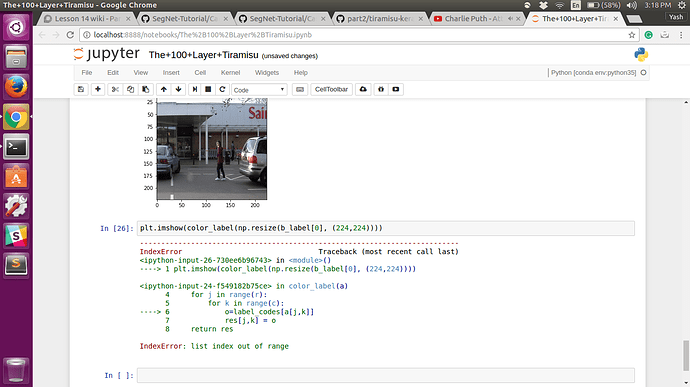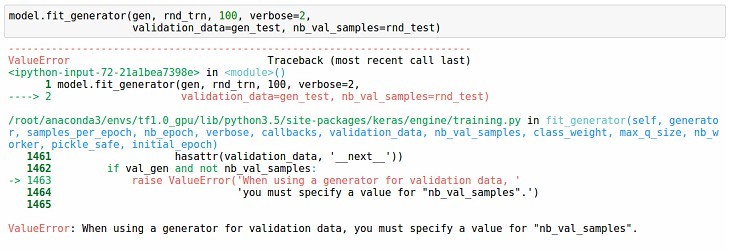Thanks - that’s much nicer!
@jeremy @rachel I was implementing the Tiramisu code and got an error in the ‘color_label’ function. This is the link my notebook https://gist.github.com/yashk2810/0aa2aa0af70c5c23cb1fc20c01277e62
Also, which dataset are you using? I used this [https://github.com/mostafaizz/camvid](https://github.com/mostafaizz/camvid). The shape of your labels is (701, 360, 480) but mine is (701, 360, 480, 3).
Moreover, you created labels_int but replaced it with labels in the Test set section. So why are you creating that variable?
Don’t take the details of that notebook too seriously, especially around how the labels are manipulated - I was using different labels from different places as I found various datasets. You should focus on what dataset you’re using, and figure out what steps you need to take - just use my code as a source of tips if you get stuck; don’t use it as something you just run through from top to bottom!
Hi, all,
I try to run through “tiramisu-keras.ipynb”. However, I came across this error at model.fit_generator() function.
I guess that’s the Keras version mismatch problem. Could someone reply me the exact Keras version as well as tensorflow version for running “tiramisu-keras.ipynb” ?
(My system currently runs Keras 1.2.2 and tensorflow 1.0, in python 3.5)
Thanks!
@amiltonwong, I don’t think this is a version conflict. You aren’t passing the right data to fit_generator. From your screenshot I can not tell what you are actually passing, but gen_test should be a generator which outputs a tuple of (X_val, y_val), being images and labels respectively. The value passed to nb_val_samples should be an integer of how many samples the generator will pass to the model.
This is changed in Keras 2, I believe? Do you know how to modify the generators for the new fit_generator function?
Did you get any solution?
@alibaba Yes. You can refer my code https://github.com/yashk2810/Semantic-Image-Segmentation
Thanks !!
@iNLyze I Was Able to get 87 % accuracy on train set and 84.06 % on Validation set…using the below Notebook with almost 500 Epochs…
Below is my link to the notebook
Pls Suggest…
@iNLyze if you could Share your notebook for reference…
Does anyone know an automatic way of deploying a notebook with all its dependencies to GitHub? Checking manually is time consuming.
@akshaylamba, done it. Let me know what you think.
pla help understand how to find pages for another lectures like lesson 13
When is the podcast coming out?! 


Note: the complete collection of Part 2 video timelines is available in a single thread for keyword search.
Part 2: complete collection of video timelines
Lesson 14 video timeline:
00:01:25 Time-Series and Structured Data
& “Patient Mortality Risk Predictions in Pediatric Intensive Care, using RNN’s” (research)
00:07:30 Time-Series with Rossmann Store Sales (Kaggle)
& 3rd place solution with "a very uncool NN ^!^ ".
00:18:00 Implementing the Rossman solution with Keras + TensorFlow + Pandas + Sklearn
Building Tables & Exploratory Data Analysis (EDA)
00:27:15 Digress: categorical variable encodings and “Vtreat for R”
00:30:15 Back to Rossmann solution
& “Python for Data Analysis” (book)
00:36:30 What Jeremy does everytime he sees a ‘date’ in a structured ML model
& other tips
00:43:00 Dealing with duration of special events (holidays, promotions) in Time-Series
00:52:00 Using ‘inplace=True’ in .drop(), & a look at our final ‘feature engineering’ results
00:53:40 Starting to feed our NN
& using pickle.dump() for storage encodings
01:00:45 “Their big mistake” and how they could have won #1
01:05:30 Splitting into Training and Test, but not randomly
01:08:20 Why they modified their Sales Target with np.log()/max_log_y
01:11:20 A look at our basic model
01:14:45 Training our model and questions
01:16:45 Running the same model with XGBoost
01:20:10 “The really, really, really weird things here !”
& end of the Rossmann coverage 
01:26:30 Taxi Trajectory Prediction (Kaggle) with “another uncool NN” Time-Series winner
01:38:00 “Start with a Conv layer and pass it to an RNN” question and research
01:42:40 The 100-layers Tiramisu: Fully Convolutional DenseNets, for Image Segmentation (Lesson 13 cont.)
01:58:00 Building and training the Tiramisu model
02:02:50 ENet and LINKNet models: better than the Tiramisu ?
02:04:00 Part 2: conclusion and next steps
Where do we find the data for “pkl_path = ‘/data/jhoward/github/entity-embedding-rossmann/’”?
- We don’t seem to generate it in the code.
- It’s not in the files downloaded.
- I don’t see it in the Wiki.
- Haven’t found it on Github.
Did I just miss it?
The file is created with the code in prepare_features.py you can find in the original paper github repo
Hi All –
I have a question about the performance of @jeremy’s Rossmann model. It looks like he gets to loss=0.1108 w/ the neural network and loss=0.1138 w/ the GBM. However, on the Kaggle leaderboard, Neokami gets down to loss=0.10583.
Does anyone know what the explanation for the gap is? Are the train/eval datasets slightly different? Is the performance reported in the notebook actually from one of Jeremy’s variations on the original model? I haven’t had a chance to step through the code yet, but thought someone here may have some insight.
Thanks
Ben
He said that it might because of the third place removed all no-sales data point.
I have a question for Rossman’s 3rd place method. I checked their github code and I can successfully repeat the model training part for both version. But however I have difficulties on get the embedding layer weights.
I am trying to use some code like: model.layers[0].get_weights() to get embedding layer’s weights. it returns “[]”, an empty list. Any idea how can I get that weights part?
The model structure is:
Layer (type) Output Shape Param # Connected to
embedding_51 (Embedding) (None, 1, 50) 55750
reshape_51 (Reshape) (None, 50) 0
embedding_52 (Embedding) (None, 1, 6) 42
reshape_52 (Reshape) (None, 6) 0
dense_25 (Dense) (None, 1) 2
embedding_53 (Embedding) (None, 1, 2) 6
reshape_53 (Reshape) (None, 2) 0
embedding_54 (Embedding) (None, 1, 6) 72
reshape_54 (Reshape) (None, 6) 0
embedding_55 (Embedding) (None, 1, 10) 310
reshape_55 (Reshape) (None, 10) 0
embedding_56 (Embedding) (None, 1, 3) 12
reshape_56 (Reshape) (None, 3) 0
dense_26 (Dense) (None, 1) 2
embedding_57 (Embedding) (None, 1, 2) 50
reshape_57 (Reshape) (None, 2) 0
embedding_58 (Embedding) (None, 1, 1) 26
reshape_58 (Reshape) (None, 1) 0
embedding_59 (Embedding) (None, 1, 1) 4
reshape_59 (Reshape) (None, 1) 0
dense_27 (Dense) (None, 1) 2
embedding_60 (Embedding) (None, 1, 2) 10
reshape_60 (Reshape) (None, 2) 0
embedding_61 (Embedding) (None, 1, 3) 12
reshape_61 (Reshape) (None, 3) 0
embedding_62 (Embedding) (None, 1, 3) 12
reshape_62 (Reshape) (None, 3) 0
embedding_63 (Embedding) (None, 1, 4) 72
reshape_63 (Reshape) (None, 4) 0
embedding_64 (Embedding) (None, 1, 4) 32
reshape_64 (Reshape) (None, 4) 0
embedding_65 (Embedding) (None, 1, 6) 72
reshape_65 (Reshape) (None, 6) 0
embedding_66 (Embedding) (None, 1, 2) 106
reshape_66 (Reshape) (None, 2) 0
dense_28 (Dense) (None, 3) 12
dense_29 (Dense) (None, 3) 12
dense_30 (Dense) (None, 2) 6
dense_31 (Dense) (None, 1) 2
embedding_67 (Embedding) (None, 1, 4) 88
reshape_67 (Reshape) (None, 4) 0
embedding_68 (Embedding) (None, 1, 1) 8
reshape_68 (Reshape) (None, 1) 0
embedding_69 (Embedding) (None, 1, 1) 8
reshape_69 (Reshape) (None, 1) 0
embedding_70 (Embedding) (None, 1, 1) 8
reshape_70 (Reshape) (None, 1) 0
embedding_71 (Embedding) (None, 1, 1) 8
reshape_71 (Reshape) (None, 1) 0
embedding_72 (Embedding) (None, 1, 1) 3
reshape_72 (Reshape) (None, 1) 0
embedding_73 (Embedding) (None, 1, 1) 3
reshape_73 (Reshape) (None, 1) 0
embedding_74 (Embedding) (None, 1, 1) 8
reshape_74 (Reshape) (None, 1) 0
embedding_75 (Embedding) (None, 1, 1) 8
reshape_75 (Reshape) (None, 1) 0
dense_32 (Dense) (None, 1) 2
dense_33 (Dense) (None, 1) 2
dropout_3 (Dropout) (None, 131) 0 merge_3[0][0]
dense_34 (Dense) (None, 1000) 132000 dropout_3[0][0]
activation_7 (Activation) (None, 1000) 0 dense_34[0][0]
dense_35 (Dense) (None, 500) 500500 activation_7[0][0]
activation_8 (Activation) (None, 500) 0 dense_35[0][0]
dense_36 (Dense) (None, 1) 501 activation_8[0][0]
activation_9 (Activation) (None, 1) 0 dense_36[0][0]
Total params: 689,773
Trainable params: 689,773
Non-trainable params: 0

